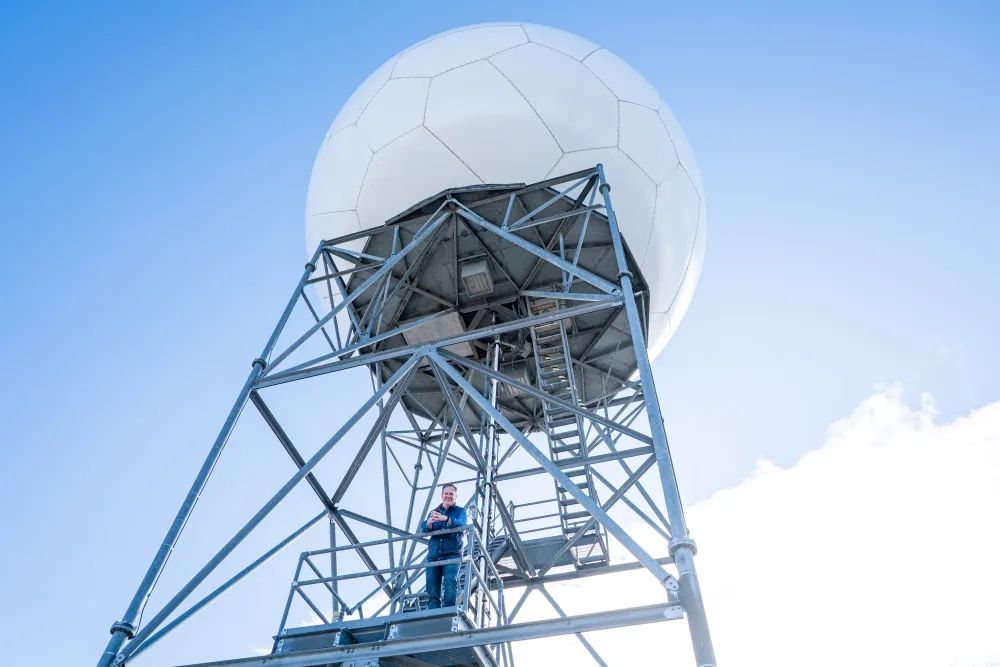
The Evolution of Weather Forecasting
March 2023
by stephanie hobby | photos by jamie blotske
When you see a vibrant red sunrise, do you - as any good sailor of days gone by - take warning? Forecasting weather through lore is entertaining but not accurate or reliable, particularly when the stakes are high. Decision-makers need solid predictions to know when to harvest, whether to gear up for a severe storm, or how to manage river flows. When it’s wrong, there are serious and costly consequences.
History of Weather Prediction Through the Years
Weather prediction in America goes back to the beginning of our then largely agrarian nation. When Thomas Jefferson was in Philadelphia to adopt the Declaration of Independence, he purchased a thermometer and a barometer, one of the nation’s first. And George Washington (another avid weather watcher) kept detailed notes until the day before his death.
- Mid 1800s- First nationwide weather observation network formed thanks to the newly-invented telegraph.
- 1849- First weather map created. 150 volunteers could report findings at one central location- the Smithsonian Institution.
- 1860- 500 stations sending reports to the Washington Evening Star but ended with the start of the Civil War.
- 1870- the Secretary of War took measurements at military stations across the continent alerting the nation of coming storms.
- September 8, 1900- Deadliest storm in U.S. history slammed into Galveston, Texas leaving six-12 thousand dead in its wake.
- June 6, 1944 (D-Day)- an accurate forecast led to the successful Normandy invasion when storms just days earlier held the possibility of capsizing boats, posing a more formidable threat than the Nazis. The general public realized the importance of investing time and taxpayer money into weather prediction.
Weather Prediction at Present
Today, a boiled-down, hourly forecast is delivered to our phones based on our precise, pinpointed location. So, we can determine whether we should run to the store in the morning or wait until after lunch to avoid the rain. Even in the remotest spots across Montana, it’s possible to get a local forecast. So, what has changed?
According to National Weather Service Supervisory Meteorologist-in-Charge, Keith Meier, a lot. Meier started at the NWS in the mid-1990s, when Montana’s weather was forecast in eight giant regions, meaning Billings and Baker, more than 200 miles apart, got the same forecast. Predictions were no more than three days out. By the late 1990s, the NWS was pushing for a five-day forecast. “It led to a near-revolt among forecasters,” laughed Meier. “And now we put out a seven-day forecast that’s pretty rock-solid.”
Meier recalls the first few days of last November, which served up stunningly beautiful weather, but change was - literally - on the horizon. Storms were brewing in the Western Pacific. By the end of October, Meier and his team were working to alert the public of impending winter conditions. “The details might change, but there’s a lot more knowledge of those interactions than there was 30 years ago,” he said. Sure enough, by November 7, winter hit, abruptly dumping six inches of snow in Billings by November 9.
Much progress is the direct result of satellite imagery and advanced computing power. Models are programmed with math and an understanding of physics, but computers in the 1950s were so slow that the joke was that it would take 15 hours to generate a 12-hour forecast.
Today, the National Weather Service runs a supercomputer in Washington, D.C., that churns out predictions for six square-mile blocks across the country; the Europeans and Canadians have similar systems, and information is shared across the globe. These computers run models hundreds of times based on their data, each with a slightly different outcome. That information gets delivered to the local Billings NWS office, where meteorologists suss out the details and can drill down to even more precise levels to help wildland firefighters or farmers harvesting crops.
Every time a scenario is run, it can generate a slightly different forecast. So, while the Weather Service might know a storm is headed to Montana, they might not know with complete precision where the snow will fall. “Sometimes that uncertainty is very tight, and other times it’s very wide,” Meier said, adding that the challenge is communicating that uncertainty to people. So, when you hear that there’s a 70 percent chance of snow on your weather app, it’s actually more complicated; models change with the constant flow of data but get more accurate closer to the date.
“I talk to my team about hitting the target. Seven days out, you’d like to hit the bullseye, but in reality, the goal should be to just hit the target. As we get closer and closer, of course, we’re aiming for the bullseye, because bullseyes matter at that point. You get inside a couple of days when someone needs to use that information to make a decision, and the stakes are a little higher,” Meier said. Snow plows need to be scheduled, and schools need to prepare to close. “Our goal is that a decision maker doesn’t wake up that morning and say, ‘Where did this come from?’” Meier said.
Looking Forward to Future Weather Prediction
Researchers continue working to harness greater computing power, particularly to predict tornadoes and severe thunderstorms, which develop remarkably fast. The aim is to alert people hours in advance, far more than the current half-an-hour notice, and to communicate when a threat will or won’t materialize.
“Our job is protection of life and property and enhancement of the national economy, so if a business or contractor isn’t having to waste money to spend for a contingency they don’t have to worry about, that enhances the economy,” Meier said.
While Meier is at the end of his career and looking forward to retirement, he’s anxious to see what happens. “For somebody like me, who’s been at this 35 years, it’s mind-boggling that we can do what we do, and it’s only going to get better as computing power gets better and the use of artificial intelligence machinery increases,” Meier said. “It’s very exciting.”
Originally printed in the March 2023 issue of Simply Local Magazine
Never miss an issue, check out SLM's digital editions here!





